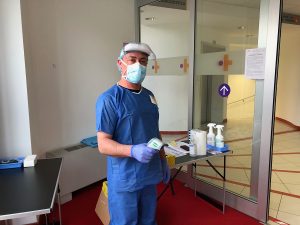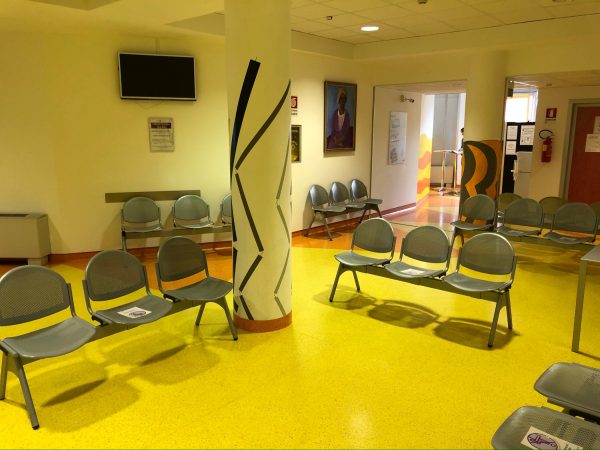Expanding patient hours

Cheryl Guttman Krader
Published: Sunday, May 10, 2020
 Triage session at the facility entrance[/caption]
Italy was hit early and hard by the COVID-19 pandemic, but restrictions in the country began to ease as April came to a close. Roberto Bellucci, MD, who practices in Verona, said that by June 1, office and surgical activity should be back to normal. As appointments fill up, Dr Bellucci said it will be necessary to expand patient care hours to accommodate the volume and new scheduling plan. “I used to book one patient every 15 minutes. Now, each appointment is being planned for 30 minutes,” he said.
Other aspects of ophthalmic practice, however, will reflect the new normal as measures are implemented to protect against viral transmission and infection.
Guidance on safety precautions has been developed by the Italian Society of Ophthalmology. The list of recommendations includes protocols for patient screening.
“Patients will be contacted by phone before a scheduled visit and asked a few questions about COVID-19 symptoms and possible exposure. When arriving for their appointment, patients will have their temperatures checked and be asked to sign a document stating that to the best of their knowledge, they are virus-free,” Dr Bellucci.
Masks and gloves will be required for anyone who comes to the office and used by all office staff. Wearing of protective face masks outside of the home was already mandated in Italy. Patients will be informed that they will need to wear gloves, but Dr Bellucci said he will have gloves available if patients have none. Each patient will be allowed to be accompanied by a single individual who must also wear a mask and gloves. All persons in the waiting area will be kept 2m apart.
“I am fortunate to have a generously sized waiting area that will allow me to accommodate up to five patients, each with an accompanying person, and still maintain the required distance between them,” Dr Bellucci said.
He is also reconfiguring his facility to face the new challenges, has added hand disinfectant dispensers, and is changing routine for patient flow.
“Patients will be admitted to specific areas one by one,” he said.
Plastic drapes have been installed as a barrier on examination instruments, and chin and forehead rests will be disinfected between patients. Dr Bellucci said that he has nine trial frames and four sets of lenses for vision testing so that each piece needs to be used only once or twice a day. All pieces will be disinfected after each use.
[caption id="attachment_19816" align="alignleft" width="600"]
Triage session at the facility entrance[/caption]
Italy was hit early and hard by the COVID-19 pandemic, but restrictions in the country began to ease as April came to a close. Roberto Bellucci, MD, who practices in Verona, said that by June 1, office and surgical activity should be back to normal. As appointments fill up, Dr Bellucci said it will be necessary to expand patient care hours to accommodate the volume and new scheduling plan. “I used to book one patient every 15 minutes. Now, each appointment is being planned for 30 minutes,” he said.
Other aspects of ophthalmic practice, however, will reflect the new normal as measures are implemented to protect against viral transmission and infection.
Guidance on safety precautions has been developed by the Italian Society of Ophthalmology. The list of recommendations includes protocols for patient screening.
“Patients will be contacted by phone before a scheduled visit and asked a few questions about COVID-19 symptoms and possible exposure. When arriving for their appointment, patients will have their temperatures checked and be asked to sign a document stating that to the best of their knowledge, they are virus-free,” Dr Bellucci.
Masks and gloves will be required for anyone who comes to the office and used by all office staff. Wearing of protective face masks outside of the home was already mandated in Italy. Patients will be informed that they will need to wear gloves, but Dr Bellucci said he will have gloves available if patients have none. Each patient will be allowed to be accompanied by a single individual who must also wear a mask and gloves. All persons in the waiting area will be kept 2m apart.
“I am fortunate to have a generously sized waiting area that will allow me to accommodate up to five patients, each with an accompanying person, and still maintain the required distance between them,” Dr Bellucci said.
He is also reconfiguring his facility to face the new challenges, has added hand disinfectant dispensers, and is changing routine for patient flow.
“Patients will be admitted to specific areas one by one,” he said.
Plastic drapes have been installed as a barrier on examination instruments, and chin and forehead rests will be disinfected between patients. Dr Bellucci said that he has nine trial frames and four sets of lenses for vision testing so that each piece needs to be used only once or twice a day. All pieces will be disinfected after each use.
[caption id="attachment_19816" align="alignleft" width="600"] The waiting room organised in zones[/caption]
Intraocular pressure is measured with rebound tonometry that uses a new disposable needle for each patient. Dr Bellucci said he is not planning to rely more on single-use instruments. “My preference is for reusable equipment and to have several of each so that a disinfected instrument is always ready to use for the next patient,” he explained.
Staff have been contacting patients to reschedule their appointments, but regulatory restrictions combined with fear of infection have led many patients to defer their visit or surgery. As appointments fill up, Dr Bellucci said it will be necessary to expand patient care hours to accommodate the volume and new scheduling plan.
Dr Bellucci observed that public hospitals that had a 12-month waiting list before COVID-19 will require a special programme to face the demand of cancelled appointments.
“This is especially true for cataract surgery for which nearly 100,000 cases were cancelled in Italy,” Dr Bellucci said.
Although telemedicine visits were implemented during the pandemic, Dr Bellucci does not believe that it will continue to have role in direct patient care. On the other hand, he expects it will gain prominence as a tool for medical education
“There is no clear regulation of the legal aspects of telemedicine for patient care, but many ophthalmology educational webinars are being promoted already,” Dr Bellucci said.
The waiting room organised in zones[/caption]
Intraocular pressure is measured with rebound tonometry that uses a new disposable needle for each patient. Dr Bellucci said he is not planning to rely more on single-use instruments. “My preference is for reusable equipment and to have several of each so that a disinfected instrument is always ready to use for the next patient,” he explained.
Staff have been contacting patients to reschedule their appointments, but regulatory restrictions combined with fear of infection have led many patients to defer their visit or surgery. As appointments fill up, Dr Bellucci said it will be necessary to expand patient care hours to accommodate the volume and new scheduling plan.
Dr Bellucci observed that public hospitals that had a 12-month waiting list before COVID-19 will require a special programme to face the demand of cancelled appointments.
“This is especially true for cataract surgery for which nearly 100,000 cases were cancelled in Italy,” Dr Bellucci said.
Although telemedicine visits were implemented during the pandemic, Dr Bellucci does not believe that it will continue to have role in direct patient care. On the other hand, he expects it will gain prominence as a tool for medical education
“There is no clear regulation of the legal aspects of telemedicine for patient care, but many ophthalmology educational webinars are being promoted already,” Dr Bellucci said.